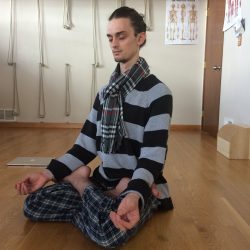Ever wonder why you have a hard time in a pose? Maybe you are feeling the pull of your hamstrings in a forward bend, or tightness in your thighs in a backward extension, or simply the inability to release and lengthen your spine. While these problems arise from different parts of the body the answer to letting go of tension is pretty straight forward. You must be able to identify that you are fighting the pose (awareness), ease off physically (detachment), and use your breath (pranayama) to explore an alternative route. You can learn to skillfully release tension by understanding how the practice of yoga affects the body physically, mentally and emotionally.
 First, learn to look inward at the beginning of class to know where you are from an energetic standpoint. Yoga philosophy sees all matter as containing three subtle qualities of nature called gunas. The gunas are always present in varying amounts and correspond to either Tamas -darkness, heaviness, torpor, Ragas -lightness, movement, willful, or Sattva -harmony, balance, illumination. We are always working to balance the three gunas (within ourselves) and move toward a Sattvic state, with the ultimate goal to rise above the gunas completely. Humans have the ability to consciously shift the predominance of one guna over another through their actions.
First, learn to look inward at the beginning of class to know where you are from an energetic standpoint. Yoga philosophy sees all matter as containing three subtle qualities of nature called gunas. The gunas are always present in varying amounts and correspond to either Tamas -darkness, heaviness, torpor, Ragas -lightness, movement, willful, or Sattva -harmony, balance, illumination. We are always working to balance the three gunas (within ourselves) and move toward a Sattvic state, with the ultimate goal to rise above the gunas completely. Humans have the ability to consciously shift the predominance of one guna over another through their actions.
In yoga for instance, when we practice a sequence to balance emotions we influence shifts in the gunas that call forth a sattvic state of mind (balanced, at ease). Have you ever left a class energized when you came in tired? When we practice sequences like backbends we call forth a rajasic (willful energetic) state that can have an overall energizing effect on an otherwise tamasic (lethargic tired) body. Of course we always try to sequence a practice to bring ourselves to a balanced state of mind by the end of the practice. Part of the ease you feel at the end of a good yoga session is a reflection of the shift that occurs in your energetic fields.
Let’s consider for a moment the impact of emotional tension. Let’s say you arrive to class in a tizz because you’re running late or have argued with a loved one earlier in the day. You are tense, anxious and distracted. Your body has appropriately responded with a flood of stress hormones designed to help you literally run away from your fear. Now you sit agitated and angry. Ready for yoga. You begin with the preliminary actions of lifting the spine and aligning the body, extending outward from the center of your being. Then you relax the muscles of your face and turn your awareness to the breath. As you slowly move from the outer sheath of the physical body (the surface) toward the inner sheathes (the breath, the mind, the intellect, the soul) you become more attentive to the body and the emotional turmoil wanes.
Second, connect to your breath to create alignment between your body, mind and intellect. The breath is the bridge between the body and the mind and it is one of the finest methods there is to stabilize and calm the mind. At first the connection may seem subtle but with time and practice you can increase the strength of your awareness of the connection and you can use it in the asana practice. When the body is locked in a pose that is going nowhere because of tension, maintain the shape of the pose but ease off the physical actions and reestablish breath awareness. Look beneath the physical tension to the thread of the breath that is connecting you to the body. The practice of breath awareness and expansion is the fourth limb of yoga, Pranayama. As Yoga Sutra II.52 translates Pranayama removes the veil covering the light of knowledge and heralds the dawn of wisdom.

Join us this Saturday, February 20 from 10-Noon for Connect To The Spine Workshop where we will develop these skills together. Cost is $20. Register today. Space is limited. For more on the gunas.


